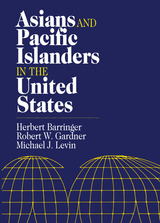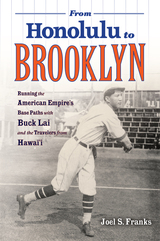2 books about Pacific Islander Americans

Asians and Pacific Islanders in the United States
Herbert Barringer
Russell Sage Foundation, 1993
Asians and Pacific Islanders in the United States examines in comprehensive detail the most rapidly growing and quickly changing minority group in the United States. Once a small population, this group is now recognized by official census counts and by society as a diverse people, comprised of Japanese, Chinese, Koreans, Filipinos, Hawaiians, Samoans, and many other heritages. However, the conception that Asians are a single and successful model minority still exists, though they are in fact a complex and multidimensional people still struggling in the pursuit of the American dream. "...a major addition to the literature on recent immigration. The book is lucidly written by three demographers eager to convey their findings and analyses to general readers as well as to fellow professionals. It provides easily accessible information and useful commentary, making it an excellent resource for anyone interested in those groups now lumped together under a single Census Bureau rubric." —Choice "This is a demographer's delight....The major question addressed in this book is: How well are the new Asian immigrants adapting to American society? Barringer, Gardner, and Levin cogently argue and convincingly demonstrate that the response to the question is much more complex than suggested by articles in the popular press....an important book and highly recommended." —Contemporary Sociology "For the real scoop on the state of Asian America, turn to the Russell Sage Foundation's excellent Asians and Pacific Islanders of the United States. The best demographic overview, it makes a strong case for Asian-American success without overlooking genuine problems." —Reason "...a comprehensive study of the size, diversity, and complexity of the Asian and Pacific Islander populations based on the 1980 census and subsequent mid-census assessments prior to the 1990 census....sheds a particularly interesting light on the shifting nature of recent Asian and Pacific Islander immigration and the related but often undocumented secondary movement of populations after arrival." —The Annals of the American Academy of Political and Social Science A Volume in the Russell Sage Foundation Census Series
[more]

From Honolulu to Brooklyn
Running the American Empire’s Base Paths with Buck Lai and the Travelers from Hawai’i
Joel S. Franks
Rutgers University Press, 2022
From 1912 to 1916, a group of baseball players from Hawaiʻ i barnstormed the U.S. mainland. While initially all Chinese, the Travelers became more multiethnic and multiracial with ballplayers possessing Chinese, Japanese, Hawaiian, and European ancestries. As a group and as individuals the Travelers' experiences represent a still much too marginalized facet of baseball and sport history. Arguably, they traveled more miles and played in more ball parks in the American empire than any other group of ballplayers of their time. Outside of the major leagues, they were likely the most famous nine of the 1910s, dominating their college opponents and more than holding their own against top-flight white and black independent teams. And once the Travelers’ journeys were done, a team leader and star Buck Lai gained fame in independent baseball on the East Coast of the U.S., while former teammates ran base paths and ran for political office as they confronted racism and colonialism in Hawaiʻ i.
[more]
READERS
Browse our collection.
PUBLISHERS
See BiblioVault's publisher services.
STUDENT SERVICES
Files for college accessibility offices.
UChicago Accessibility Resources
home | accessibility | search | about | contact us
BiblioVault ® 2001 - 2024
The University of Chicago Press









